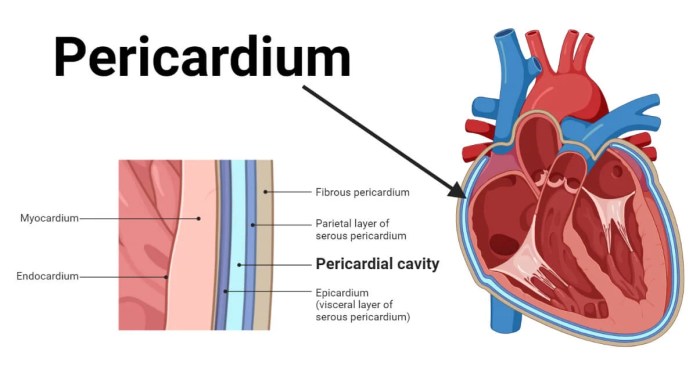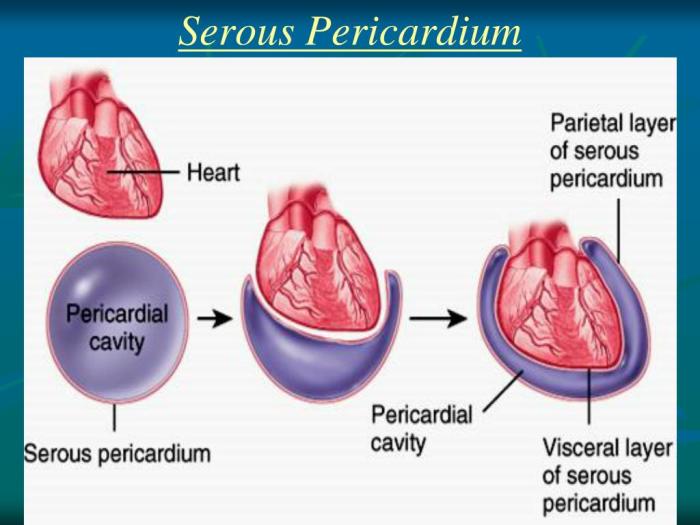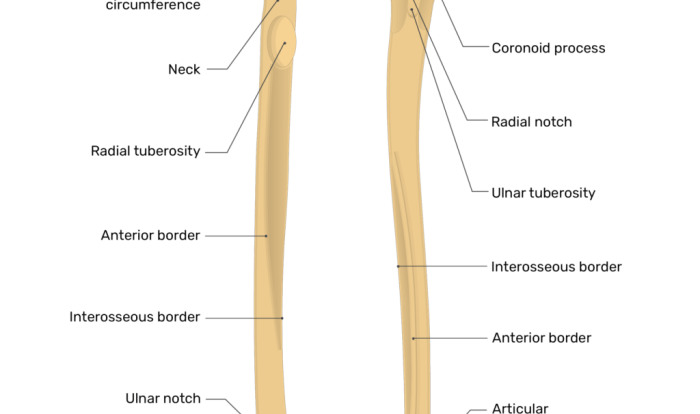Match the following structure with its description serous pericardium – The serous pericardium, a crucial component of the heart’s protective layers, plays a pivotal role in maintaining the heart’s proper functioning. This article delves into the intricate structure and functions of the serous pericardium, exploring its anatomical location, cellular composition, innervation, blood supply, and clinical significance.
Composed of two layers, the serous pericardium lines the fibrous pericardium and covers the heart, providing a smooth surface that minimizes friction during cardiac contractions. The serosal layer, facing the heart, is lined with mesothelial cells that secrete a lubricating fluid, while the parietal layer, adjacent to the fibrous pericardium, consists of connective tissue.
Structure and Function of the Serous Pericardium: Match The Following Structure With Its Description Serous Pericardium

The serous pericardium is a double-layered sac that surrounds the heart. The outer layer, called the parietal pericardium, is attached to the inner surface of the chest wall. The inner layer, called the visceral pericardium, is attached to the surface of the heart.
The two layers are separated by a small amount of fluid, which helps to lubricate the heart and prevent friction.The serous pericardium plays an important role in protecting the heart. It helps to prevent infection from spreading to the heart, and it also helps to keep the heart in place.
Histological Features of the Serous Pericardium
The serosal layer of the pericardium is composed of mesothelial cells, which are flat, polygonal cells that line the body cavities. The parietal layer of the pericardium is composed of connective tissue and blood vessels.Mesothelial cells have a number of important functions.
They secrete a fluid that lubricates the heart and prevents friction. They also help to protect the heart from infection by phagocytosing bacteria and other foreign particles.
Innervation and Blood Supply of the Serous Pericardium, Match the following structure with its description serous pericardium
The serous pericardium is innervated by the phrenic nerve. The arterial blood supply to the pericardium is derived from the pericardiophrenic arteries. The venous blood supply to the pericardium is drained by the pericardial veins.
Clinical Significance of the Serous Pericardium
Pericardial diseases are a group of conditions that affect the pericardium. These conditions can range from mild to severe, and they can be caused by a variety of factors, including infection, inflammation, and trauma.Some of the most common pericardial diseases include:
- Pericarditis: This is an inflammation of the pericardium. It can be caused by a variety of factors, including infection, autoimmune disorders, and chest trauma.
- Pericardial effusion: This is a buildup of fluid in the pericardial sac. It can be caused by a variety of factors, including pericarditis, heart failure, and kidney failure.
- Constrictive pericarditis: This is a condition in which the pericardium becomes thickened and scarred. It can lead to heart failure and other serious complications.
Pericardial diseases can be diagnosed using a variety of techniques, including:
- Physical examination: The doctor will listen to your heart and lungs and look for signs of pericardial disease.
- Chest X-ray: This can show an enlarged heart or the presence of fluid in the pericardial sac.
- Echocardiogram: This is an ultrasound of the heart that can show the thickness of the pericardium and the presence of fluid in the pericardial sac.
- Cardiac MRI: This is a type of MRI scan that can provide detailed images of the heart and pericardium.
Treatment for pericardial diseases depends on the underlying cause. In some cases, no treatment is necessary. In other cases, treatment may include medications, surgery, or a combination of both.
Detailed FAQs
What is the function of the serous pericardium?
The serous pericardium secretes a lubricating fluid that reduces friction between the heart and surrounding structures during cardiac contractions.
What are the layers of the serous pericardium?
The serous pericardium consists of two layers: the serosal layer, which lines the heart, and the parietal layer, which is adjacent to the fibrous pericardium.
What type of cells line the serosal layer of the pericardium?
The serosal layer is lined with mesothelial cells, which secrete a lubricating fluid.



